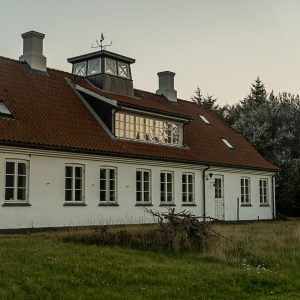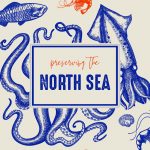Introduction, goings and coming in Thorup
Initially, the plan was to meet for lunch with Morton at his home in Thorup, North Jutland, Denmark. He is both an experienced fisherman and a teacher. Among other things, he has spent the last fourteen years leading the creation and development of the Thorupstrand Fishing Guild. His role in the group has been heterogeneous in nature: participant and researcher. Morton agreed to meet with us to discuss the guild’s formation and to organize a fishing expedition on the “Jojenu” fishing vessel. This was the most exciting part: to fish on a wooden cutter with members of the guild.
Unfortunately, our own vehicular setbacks changed the timeline–but that’s another tale. Therefore, we arrived at his home for evening tea and an informal interview at his dinner table. The owner didn’t seem to mind and appeared in good spirits.
His was the last house before the end of the street. The warehouse that the guild used for its fish processing center sat beyond it. After that was just the cold Skagerrak sand and the sea itself. Even at night, from Morton’s front window on the second floor, one could see the lights of machinery flashing against the hulls of the guild’s blue and white ships preparing to set sail.
Rather than a harbor, the boats rested directly on the dry sand itself. They required assistance sliding on and off of it. In the old days, the men would place oiled, wooden beams in the sand in front of the boats. In an organized effort, several men on shore would push the boat into the water with their own shoulders pressed against the bend of the frame. Those on board held on tight as the ship accelerated into the water. These days a mechanical winch did the job. Nevertheless, I looked forward to the thrill of being on board for such a launch in the coming days whenever it may come.
And I Digress
Despite my excitement, a series of numbers etched into the beam in the ceiling above the window facing the beach distracted my attention. Looking around, I noticed several other similar engravings. Curiously, my first question for Morton wasn’t about the guild, but about the inscription overhead.

“This is our family house,” Morton said.
I didn’t follow the logic, but I did catch the clever flash in his icy, blue eyes. The professor knew how to capture your attention. He went on to describe the seven generations of ethnographers contained within his lineage. They had lived in this house nestled up against the littoral of the Danish coastline. He’d grown up here. He had bought his first boat in this village. He’d raised his daughter between these walls.
Finally, he told us of the reconstruction he had done in recent years. The house had been modernized for greater efficiency and comfort. For the sake of sustainability and lower impact, every piece of the old house that could be re-used was cataloged and stored until they could be replaced in the new structure. The exposed beams in the ceiling were among the pieces of the former building. Therefore, they were marked and added to the index.
The Thorupstrand Fishing Guild, an Origin Story
After our introduction, Morton appeared eager to move onto the operations of the guild. He began with a detailed history of the guild’s formation. 20 families in town had united on a vote to establish a community-based cooperative. This decision came in response to a Danish law that was about to go into effect. Once enacted, the new law would revise fishing rights. Rather than being a common right to anyone with the grit and skill to catch fish, the law established a privatized mechanism known as Individual Transferable Quotas (ITQs). ITQs are commodities that can be bought and sold on the market. They establish a lord/tenant relationship between the owner of the ITQ and the fisherman on the boat. Effectively, through the establishment of ITQs, the sea was no longer open to universal fishing rights.
Instead, fishing rights became a privilege to be bought and sold. This capitalistic logic has had an industrializing effect. After passage of the law, the Danish fishing fleet rapidly contracted. This led to the consolidation of fishing rights into the hands of a few large investors. These ‘lords of the sea’ quickly accumulated ITQs by buying out locals and permanently docking their boats. The fleet size shrank. Rather than rely on numbers, the average boat size increased dramatically. These larger ships needed far fewer operators, and thanks to the mechanization and automation they relied on, the fishermen on board required less training and skill. Seaside villages dried up and disappeared or transformed into holiday homes for wealthy businessmen from Copenhagen or Aarhaus.
Thanks to the vote, Thorup became, and continues to be, the only surviving community in Denmark still maintaining the old tradition.
The Guild, Hero of Thorup
Thorup’s vote established a fishing rights collective. It served as financial oversight that permitted the continuation of a community-based economy and ‘share fishing’. Share fishing is, as the name suggests, when the fishermen onboard share the catch. After subtracting the cost of boat and material costs, the fishers split the remaining value of the fish at auction. This traditional system stood in direct opposition to the marketizing effect of ITQs. In other words, Thorup was operating outside of the system. It had discovered a new autonomous space. One that was an autonomy of the commons rather than the ‘free’ market.
By cooperating rather than competing, the fishing village has survived the transition brought about by the implementation of ITQs. But of course, there were some rules. This isn’t anarchy, after all.
Simply put, the fisherman must:
- 1) pay an entry deposit, returnable upon leaving the guild,
- 2) be on the boat to procure the fish (no fisherman is permitted to rent or loan any part of the Guild’s ITQs to anyone outside of the group), and
- 3) use traditional, low-impact fishing gear and small-scale boats. These measures help to maintain the original mission of the guild’s formation. Namely, to protect the sea and its fisheries while hand-in-hand offering broad social benefits to the town.
Sometime around 8:30 pm Morton’s phone rang, interrupting our conversation. On the other end was Anders, captain of the Jojenu. He was planning to leave in the morning, and we were welcome to join him.
“What time will we depart?” I asked.
With a wry smile Morton answered, “1 am.”
Citations
Andersen, J. L.(2012).Danish fisheries: Management, fleet structure and economic performance. Department of Food and Resource Economics, 2, 2012.
Andresen, J., & Højrup, T. (2008). The Tragedy Of Enclosure. ethnologia europaea, 38(1), 29.
Carothers, C., & Chambers, C. (2012). Fisheries privatization and the remaking of fishery systems. Environment and Society, 3(1), 39-59.
McCarthy, J. (2005). Commons as Counterhegemonic projects. Capitalism Nature Socialism, 16(1), 9-24.
Pickerill, J., & Chatterton, P. (2006). Notes towards autonomous geographies: creation, resistance and self-management as survival tactics. Progress in human geography, 30(6), 730-746.
Pinkerton, E., & Davis, R. (2015). Neoliberalism and the politics of enclosure in North American small-scale fisheries. Marine Policy, 61, 303-312.
St. Martin, K. (2005). Disrupting enclosure in New England fisheries. Capitalism Nature Socialism, 16(1), 63-80.





Recent Comments